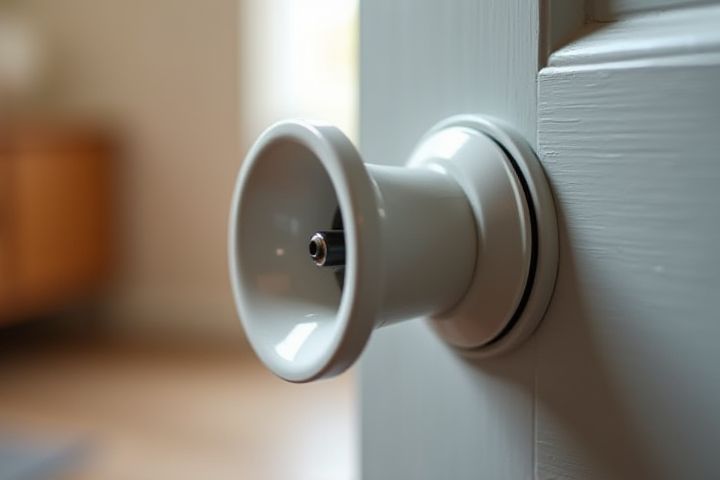
To effectively reduce house noise, consider soundproofing methods such as adding acoustic panels on walls, which absorb sound waves and minimize echoes. Insulating your windows with double or triple glazing not only enhances energy efficiency but also significantly lowers outside noise infiltration. You can also use rugs or carpets on hard floors, as they provide a soft surface that dampens sound transmission. Sealing gaps around doors and windows with weatherstripping or soundproofing caulk will prevent unwanted sound leaks. Finally, establishing a quiet environment by positioning heavy furniture against shared walls can create additional sound barriers within your home.
How To Reduce House Noise
Install weatherstripping
Installing weatherstripping is an effective method to reduce house noise, as it creates a tight seal around doors and windows, blocking sound from entering your living spaces. By choosing materials like foam tape or V-seal weatherstripping, you can enhance soundproofing while also improving energy efficiency. Proper installation involves cleaning surfaces thoroughly, measuring and cutting the weatherstripping to fit snugly, and pressing it firmly into place to ensure a secure barrier. This simple yet impactful home improvement can significantly diminish outside disturbances, resulting in a quieter, more peaceful environment for you and your family.
Use door sweeps
Door sweeps are an effective solution for reducing house noise, as they seal the gap between the bottom of your door and the floor. Installing a door sweep can reduce sound transmission by up to 60%, significantly improving your home's acoustics. Choose a door sweep made of dense materials like silicone or rubber for optimal noise reduction. You can easily install these door sweeps yourself, ensuring a snug fit that keeps unwanted noise outside while enhancing your living environment.
Add acoustic panels
Acoustic panels are an effective solution for reducing noise in your home, as they absorb sound waves and minimize echo. Typically made from dense foam or fabric-wrapped materials, these panels can lower noise levels by up to 50% when installed properly. Strategically placing them in areas with high sound reflection, like living rooms or home theaters, maximizes their effectiveness. Consider using a combination of different panel types and sizes to enhance your soundproofing efforts and improve overall acoustic quality.
Seal gaps and cracks
To effectively reduce house noise, prioritize sealing gaps and cracks around windows, doors, and walls. Use high-quality caulk or weatherstripping to fill gaps as small as 1/8 inch, which can significantly decrease sound infiltration. Insulating your walls with soundproofing materials like acoustic panels or foam can also enhance your home's noise reduction capability by up to 50%. Regularly inspecting and maintaining these seals will ensure your living space remains peaceful and quiet year-round.
Hang heavy curtains
Hang heavy curtains to significantly reduce noise infiltration into your home. These dense fabrics can absorb sound waves, effectively diminishing echoes and outside disturbances. Opt for curtains that extend beyond the window frame, preferably reaching the floor, to enhance their sound-dampening capabilities. For maximum noise reduction, consider adding a blackout liner, which can further block sound and light, creating a quieter, more serene environment.
Use rugs and carpets
Using rugs and carpets can significantly reduce house noise by absorbing sound waves and minimizing echoes in your living space. Thick, plush carpets are particularly effective at dampening footfall noise, making your home quieter and more comfortable. Additionally, strategically placing area rugs in high-traffic zones can further enhance sound insulation and transform your floor aesthetics. You can choose rugs with dense fibers or thick padding to maximize their noise-reducing properties, while also complementing your interior design.
Upgrade windows
To significantly reduce house noise, consider upgrading to double or triple-pane windows, which can lower sound transmission by up to 50%. These windows are designed with an insulating gas between panes, enhancing their soundproofing abilities. You can also look for windows with a Sound Transmission Class (STC) rating of 30 or higher for optimal noise reduction. Sealing gaps and using acoustic caulk around window frames further improves sound insulation, ensuring a quieter living environment.
Install soundproof doors
Installing soundproof doors can significantly reduce house noise, enhancing your living environment. Soundproof doors typically feature solid cores made from materials like steel or wood, which can block up to 30 decibels of sound. Choosing doors with weatherstripping and soundproof seals further minimizes noise infiltration from outside. To maximize effectiveness, ensure proper installation, leaving minimal gaps that sound can leak through, contributing to a quieter space for you and your family.
Use furniture to block noise
Using furniture strategically can significantly reduce noise in your home. For instance, placing heavy bookshelves against walls can act as sound barriers, absorbing and deflecting sound waves. Incorporating upholstered furniture, such as sofas and armchairs, can further dampen noise, with each piece adding to the overall sound insulation. You can also utilize rugs and carpets to help minimize echo and create a quieter atmosphere, making your living space more serene and enjoyable.
Apply noise-reducing paint
Applying noise-reducing paint can significantly diminish sound transmission within your home. This specialized paint contains sound-dampening materials that absorb vibrations and reduce echo, making your environment quieter. For optimal results, consider a high-quality brand that offers at least a Sound Transmission Class (STC) rating of 30 or higher. A two-coat application over your interior walls can lead to a noticeable decrease in noise levels, enhancing your living experience.
